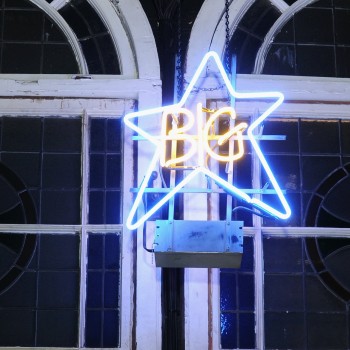Today, jangle-pop pioneers Big Star are almost universally recognized as one of the most influential bands of the ’70s. But they released just three records and achieved only limited commercial success.
Filmmaker Drew DeNicola’s new documentary, “Big Star: Nothing Can Hurt Me,” examines the story of the band he calls “the ultimate beautiful losers.” So we asked him to give us a little insight into Big Star’s rise, fall, and eventual place in the American pop cannon.

Brendan Francis Newnam: So Big Star kind of had a Lennon-McCartney thing going on. They’re these young guys from Memphis, Tennessee. Initially, there were two main songwriters: Alex Chilton, who was a local kid who had become a national success at a young age as the singer of The Box Tops — They had that hit song “The Letter” — and Chris Bell, who’s another local, talented, ambitious musician, a bit mercurial, not as popular.
How did their different backgrounds and personalities figure into the music that they made together?
Drew DeNicola: Yeah, that’s kind of the basis when you think about these two guys. Alex had fame but did not feel it was deserved. It was his first time on the mic, he didn’t know how to play any instruments, and he was propelled into the spotlight with The Box Tops.
Brendan Francis Newnam: And he was 19 years old when he was picked to sing for them, right?
Drew DeNicola: He was 16, so very young. I think he felt a little uncool and undeserving of the fame. And as far as being 16, he missed out on his childhood, in a way. He talked about it later on in Bomp! magazine, saying that when he was writing a lot of those sentimental songs, they were an attempt to recapture what he thought was youth.
Meanwhile Chris was daydreaming in his bedroom looking at his Who posters, scheming and tying to figure out how to make the ultimate rock group. He knew he was a good player, and he had access to this studio, much in the same way that The Beatles did. Probably more, in a way, if you think about The Beatles in the early days. They had guys in lab coats that would turn the knobs for them.
Brendan Francis Newnam: But in Big Star’s case, they recorded themselves in a beautiful studio that was called Ardent. So they had talent, ambition, access to state-of-the-art equipment. What happened? How come Big Star never became a household name?
Drew DeNicola: There’s a lot of reasons. With the first record, it was that Stax wasn’t equipped to be distributing rock records. They had relationships with mom-and-pop record stores in black neighborhoods.
Brendan Francis Newnam: Stax was Big Star’s label, but it was primarily a soul music label, and Big Star was their first rock and roll act.
Drew DeNicola: Yeah, so the promo guys really didn’t know what to do with Big Star. With the second record, it had to do with what seemed to be a great idea: it was gonna be that Columbia was gonna distribute Stax, and then they would have gotten that stuff into big-box retail outlets.
But what happened there was Clive Davis, who’s hugely known in the music world, was the one who brokered that deal… and then he was fired. So the whole thing fell apart after that.
Brendan Francis Newnam: And also the music itself, right? It’s poppy and accessible and beautiful, but it’s a little idiosyncratic and has some dark undercurrents that I think weren’t necessarily radio friendly, or something people were used to hearing.
Drew DeNicola: That’s what I was interested in. I just believe it was in their DNA to fail, and they made the ultimate beautiful losers, almost like the patron saint band of any rock act that wasn’t on the radio.
Brendan Francis Newnam: They’re credited with creating “alt-rock,” for lack of a better word, and college rock like REM and The Replacements. There were some qualities to their music that spoke to those people, it wasn’t just their persona.
Drew DeNicola: Right. There was kind of a personal approach to their songwriting that might have more to do with Neil Young or Joni Mitchell in the ’70s, but that stuff was real mellow. Instead, they had this sort of Who wrapper.
Alexis Taylor from Hot Chip was saying there’s this melancholy and this exuberance at the same time, and that’s a really powerful combination that keeps you listening. It’s a mixed message in the songs and that right there renders you not commercial.
Brendan Francis Newnam: Big Star are revered among rock critics, who are a pretty geeky, intense tribe. I’m wondering if, as a director, you were intimidated to take on a band that means so much to such a vocal group?
Drew DeNicola: Thank God I won most of them over, but I was getting a lot of shade from people in the beginning.
Brendan Francis Newnam: Like “Who are you to touch Big Star?”
Drew DeNicola: Oh yeah, it was too sacred for a lot of people. A lot of people said that they didn’t want to be involved, and I think they changed their minds later when they were like, “Oh that’s pretty good, OK.”
Also, just satisfying both the hardcore fans and people that were not familiar with Big Star is still kind of a problem. During Q&A’s, I usually make sure to tell them that I’m doing 70 minutes of DVD extras, so I try to satisfy everyone.
Brendan Francis Newnam: So the geeks can go further.
Drew DeNicola: Exactly.


